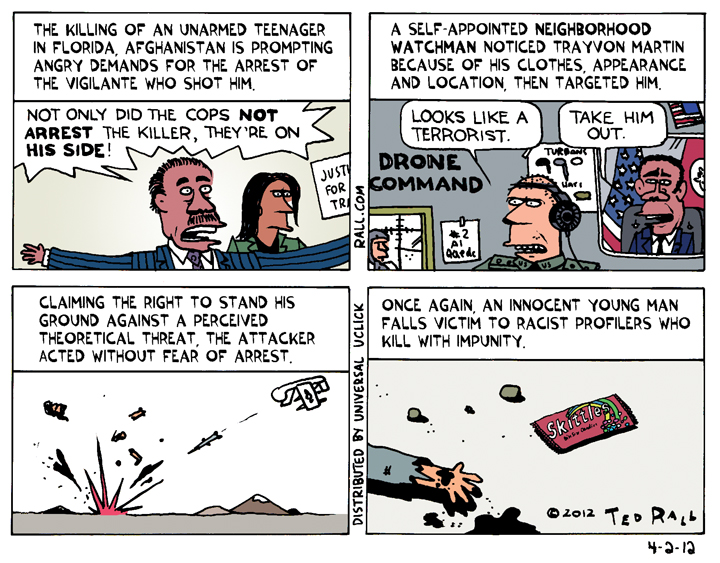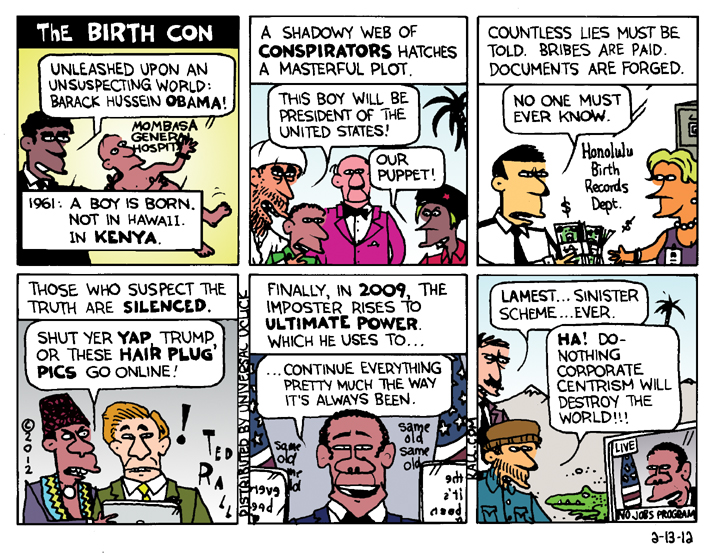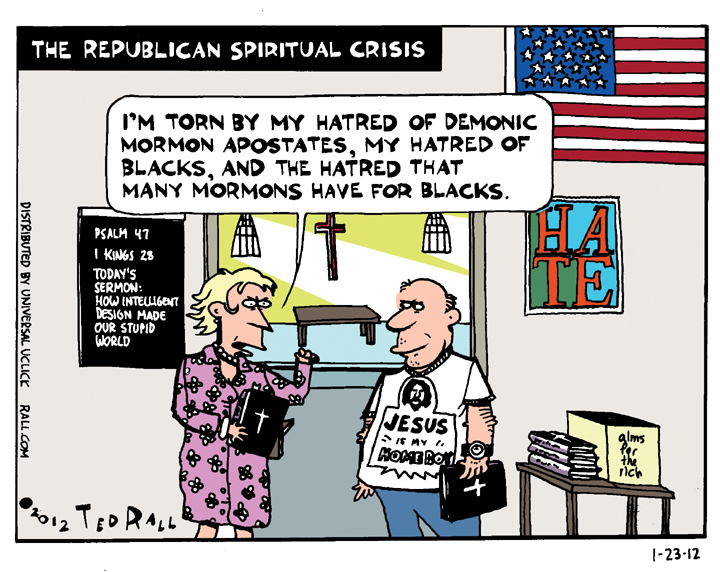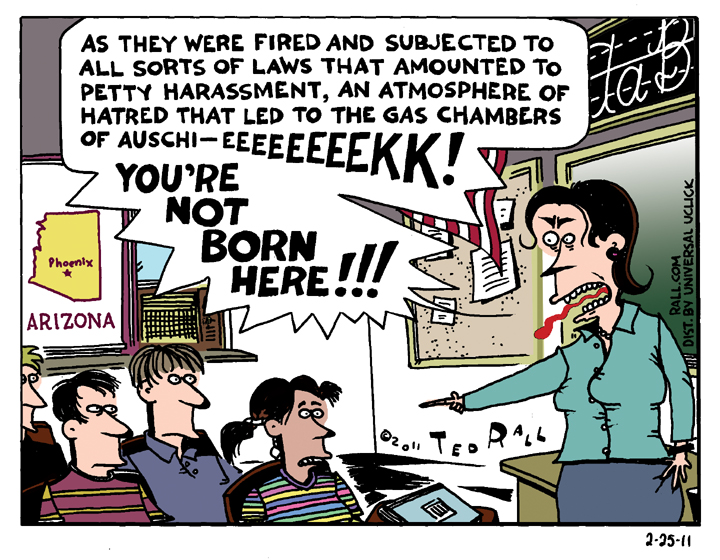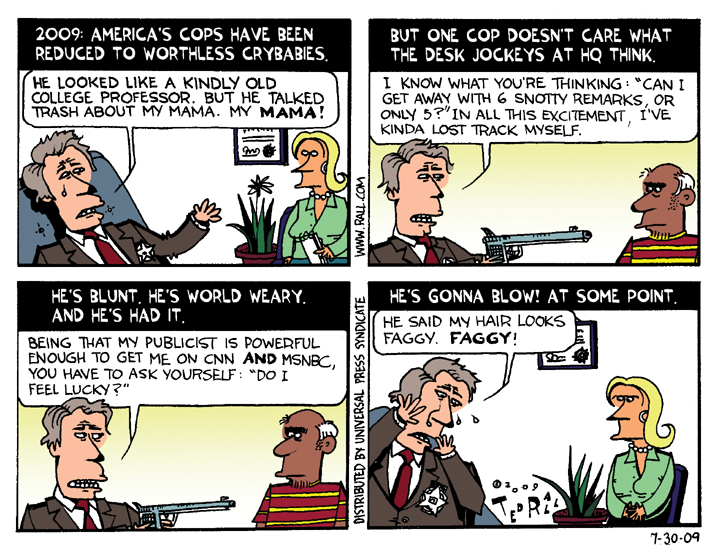Cops are like mountain lions with legal rights to strip-search you.
Racial Profiling
Trayvon Martin was a victim of racial profiling. Every day, American drone plane operators do the same thing, deciding who lives and dies in Afghanistan and Pakistan based on nothing more than the appearance, clothing and location of their victims thousands of miles away. People have been killed mistakenly simply because a drone operator thought they were wearing a black long-tailed turban, favored by some Talibs because they come from tribes that wear them.
SYNDICATED COLUMN: Handicapped
Conventional Wisdom Is Wrong. It’s Romney’s To Lose.
Catching Barack Obama in a rare moment of candor, an open mic found the president confiding to his Russian counterpart that he expects to win this fall. “This is my last election,” he told Russian President Dmitry Medvedev.
Last, yes. But I wouldn’t bet on Obama winning.
The corporate pundit class has largely conceded the general election to Obama, already looking ahead to 2016. The mainstreamers have their reasons. Their analysis is based on good, solid, reasonable (inside the box) logic. All things considered, however, I would (and have) put my money on Mitt Romney this fall.
This isn’t wishful thinking. I voted for Obama last time and wanted him to succeed. He failed. His accomplishments have been few and have amounted to sellouts to the right. Even so, the prospect of watching Mitt Romney move into the White House fills me with as much joy as an appointment for a colonoscopy. And I think he’s going to win.
For me, the D vs. R horserace is a parlor game with minor ramifications for our daily lives. Whichever corporate party wins, unemployment and underemployment will continue to worsen, income disparity will widen, and most of our taxes will fund the worst approach to international affairs since a former Austrian corporal blew out his brains out in a bunker under Berlin.
Thanks to the Occupy movement, real politics is back where it belongs—in the streets. That’s what I’ll be watching and working. With a lot of luck (and even more pepper spray) this will be a year of revolution rather than more electoral devolution.
Revolution is inevitable. But we don’t know when it’s coming. So the 2012 campaign may still matter. Besides, handicapping elections is a game I enjoy and am good at. During 17 years of syndication my pick to win has only lost once (for the 2004 Democratic nomination). So, on the off chance that you’re one of those who still cares about our husk of a democracy, who hangs on every meaningless development of a political process devoid of politics—or you’re just a betting person, here’s my thinking.
Barring an assassination or a scandal, Mitt Romney will be the Republican nominee.
Obama currently leads Romney by about four to five points. But that’s not nearly enough of a lead to carry him to November. History shows that Republican nominees steadily increase in popularity throughout the summer and fall of an election year.
In April 2004, for example, John Kerry led George W. Bush by eight points. But Swift Boating erased that lead, and then some.
In order to win, a successful Democratic nominee has to begin with a big margin. That early lead must be large enough to wind up in the black, after months of being whittled away, when the votes get counted in November. I can’t see Obama pulling far enough ahead soon.
Incumbency is a huge advantage. If the election were held tomorrow, Obama would prevail. But the election is not being held tomorrow. It’s being held in November.
By the time they head to the polls this fall, voters’ brains will be drowning in months of hundreds of millions of dollars of slick, demographically targeted, pro-Romney attack ads. Republican campaigns are more effective at this sort of thing, and as Newt Gingrich and Rick Santorum can attest, Romney’s consultants pull no punches. Obama’s current lead will be a faded memory.
Every political campaign comes down to a contest of narratives. In 2008 Obama developed an effective sales pitch: Hope and Change for a nation exhausted by eight years of Bush, 9/11, war, taking off your shoes at the airport, and a full-fledged global economic crisis to boot. Obama’s advisers turned his biggest weaknesses—his inexperience, race, unusual name and foreign background—into assets. Here was a new kind of president. Just the guy to lead us out of the Bad Old Days into something better. McCain-Palin’s narrative—a cranky old ex-POW paired with a zany housewife-gone-wild—didn’t stand a chance.
This year the narratives favor Romney.
Romney is already pointing to the biggest issue on people’s minds, the economy, and claiming that his background as a turnaround artist qualifies him to fix what ails us. His prescriptions are Republican boilerplate, vague and counterproductive, but at least he’s doing something Obama hasn’t—talking a lot about creating jobs. Voters prefer useless attentiveness to calm, steady golfing (Obama’s approach). And—despite its illogic—they like the run-government-like-a-business narrative (c.f. Ross Perot, the Bushes).
Obama is boxed in by three-plus years of inaction on, well, pretty much everything. He’ll argue that he’ll be able to “finish the job” during a second term, but that’s a tough sell when you haven’t tried to start the job—in 2009, when Democrats had huge majorities in both houses of Congress. His single signature accomplishment, healthcare reform, is disliked by two-thirds of the electorate. The recent “good news” on the economy has been either insignificant (net positive job creation of 100,000 per month for two months, less than one-tenth of one percent of the 25 million jobs needed) or falsified (discouraged workers no longer counted as unemployed).
Despite what Obama tells them, Americans know things are still getting worse. Similarly, Obama’s recent, feeble, impotent rhetorical attempts to shore up his support among his Democratic Party’s disappointed liberal base will probably not generate enough enthusiasm to counter other factors that favor Romney.
You can’t vote for the first African-American president twice. Unless he picks a woman as vice president, a vote for Obama will be a vote for the same-old, same-old. The history-making thrill is gone.
At this writing the Republican Party appears to be in disarray. No doubt, Romney is emerging from the primaries battered and bruised. His awkward and demented soundbite stylings (“corporations are people,” “the trees are the right height”) will provide fodder for countless YouTube parodies. But Romney hasn’t been damaged as much as the official political class seems to think.
Republicans are a remarkably loyal bunch. United by their many hatreds (liberals, blacks, gays, poor people, Mexicans, Muslims, foreigners, etc.), they will set aside their comparatively low simmer of anti-Mormon bigotry this fall. Picking a standard-issue white Anglo Christianist thug as veep will cinch the deal.
The GOP enjoys a huge fundraising advantage, especially via the new-fangled SuperPACs. Romney has raised $74 million against $151 million for Obama, but look for that ratio to flip after he locks up the nomination. Cue those vicious, potent ads mentioned above.
About the only major factor working for Obama is the presidential debates. Romney doesn’t stand a chance against the cool, articulate Obama.
Of course, it’s a long way to November. A lot can happen. It’s very possible for Obama to win. But that’s not how it looks now.
(Ted Rall’s next book is “The Book of Obama: How We Went From Hope and Change to the Age of Revolt,” out May 22. His website is tedrall.com.)
SYNDICATED COLUMN: Occupy Main Street
For America’s New Radicals, a Coming-Out Party—and Brutal Cops
“First they ignore you, then they ridicule you, then they fight you, then you win.” —Gandhi
Gandhi lost, but never mind.
#OccupyWallStreet, in its second week as of this writing, is and was important. It is the first major street protest inspired by the economic collapse that began in 2008. It is also the first notable public repudiation of Obama by the American Left. Inspired by the Arab Spring, the Canadian “culture jammer” magazine Adbusters asked people to converge on lower Manhattan’s financial district in order to protest corporate greed in general and—in a reflection of the influence of social networking culture—to develop one specific major demand after they gathered.
Several thousand people arrived 10 days ago but were turned away from Wall Street by a phalanx of NYPD officers manning metal barricades. A few hundred demonstrators, dominated by the scruffy white twentysomething college grads known as “hipsters,” wound up at Zuccotti Park, whose private owners granted them permission to camp there.
There they remain, noshing on donated pizza, talking, hanging out, hoping to replicate the magic of Cairo’s Tahrir Square while remaining committed to “absolute nonviolence in the Gandhian tradition,” as Adbusters commanded.
Occupy Wall Street now seems to be fizzling out.
For me and other older, jaded veterans of leftist struggle, failure was a foregone conclusion. From the opening words of the magazine’s updates to the participants, which it referred to as “dreamers, jammers, rabble-rousers and revolutionaries,” it was evident that yet another opportunity to agitate for real change was being wasted by well-meant wankers.
Michael Moore complained about insufficient media coverage, but this non-movement movement was doomed before it began by its refusal to coalesce around a powerful message, its failure to organize and involve the actual victims of Wall Street’s perfidy (people of color, the poor, the evicted, the unemployed, those sick from pollution, etc.), and its refusal to argue and appeal on behalf of a beleaguered working class against an arrogant, violent and unaccountable ruling elite—in other words, to settle for nothing less than the eradication of capitalism.
Don’t just occupy Wall Street.
Occupy Main Street. Get ordinary people interested and involved. After all, college kid, it’s not just your struggle.
While a lack of political education should not preclude a person from participating in politics, organizers of a movement seeking radical change should make sure they don’t waste the whole time strumming a guitar and flirting. Zuccotti Park should have offered daily classes and study groups to reduce the odds that an attendee will sound like a moron when she gets questioned by a journalist.
“I’m not for interference [with wealthy people],” The New York Times quoted protester Anna Sluka. “I hope this all gets people who have a lot to think: I’m not going to go to Barcelona for three weeks. I’m going to sponsor a small town in need.” Earth to Anna: Rich people know poor people are suffering. They don’t care.
Also, lose the clown clothes. It’s not the early 1960s; you don’t have to wear a suit like the civil rights marchers did. But how about showing up on national TV looking decent, like it’s Casual Friday?
Revolutionaries should not expect fair coverage by media outlets owned by the transnational corporations they hope to overthrow. They also shouldn’t make themselves so easy to mock. Press accounts reveled in photos of topless women and the dudes on stilts who always show up at these things. So much bad hair, so many colors that don’t occur in nature.
A protest is a stage. All over New York City and around the country, people are watching on TV. Ideally, you want viewers to drop what they’re doing, to come join you. At bare minimum, you want them to approve of you. To identify with you. Maybe even send a check.
You say you represent the “99 percent” of Americans getting screwed by the top one percent. So act like the 99 percent. Dress like them.
Be normal, inclusive and welcoming.
Reporters quoted demonstrators who sounded as ignorant about current affairs as members of the Tea Party, albeit nicer. It was a perfect set-up for hit pieces by the likes of Ginia Bellafante, who called the downtown gathering an “opportunity to air societal grievances as carnival” and slammed the “group’s lack of cohesion and its apparent wish to pantomime progressivism rather than practice it knowledgably.”
History has proven that an absolute commitment to nonviolence can never effect radical change. This was shown again on Saturday September 23rd, when police used orange plastic nets to “kettle” and arrest about 80 Occupy Wall Streeters who had been marching peacefully through Greenwich Village. According to numerous witnesses and media accounts, none resisted. Cops went wild, beating several men bloody and macing at least one woman after she had been cuffed.
Sadly, too many people angry at gangster capitalists will look at the YouTube videos of bloodied young faces and say to themselves: I’m willing to suffer for a cause, not a scene.
Back in July, Adbusters wanted the “one simple demand” expressed by Occupy Wall Street to be “that Barack Obama ordain a Presidential Commission tasked with ending the influence money has over our representatives in Washington.”
What do we want?
A bipartisan blue-ribbon commission to study the extension of campaign finance reform!
When do we want it?
As soon as the committee completes its work!
Unsurprisingly and rightly, that uninspiring (and easily satisfied) demand has been set aside in favor of something better but hardly worth taking a rubber bullet for: “a vague but certain notion that the richest percentile of the country remains fat and happy as the going-on-five-year-old recession continues to batter the middle and working class,” as The New York Observer put it.
Occupy Wall Street should have demanded something majestic, reasonable and unobtainable, in order to expose the brutal nature of the system. Something like the nationalization of all corporations, equal wages for all workers, or the abolition of securities exchanges.
Some organizers also called Occupy Wall Street “Days of Rage”; along with organization and focus, rage is what is lacking.
The aggregated wealth of the superrich has been stolen from the rest of us. We should not ask them to give some of it back. We should take it all, then jail them.
Which isn’t going to happen nonviolently.
Rich people are bad people. Someone has to say it out loud.
I have no problems with the organizers of a protest deciding that its marchers will remain nonviolent. I am speaking at such an event on October 6th. However, I think it’s unwise to broadcast those intentions to the authorities.
Few people think about it now, but street demonstrations have always relied on a sense of menace. Sure, people marching through the streets of a medieval city might begin by expressing their demands peacefully. But they drank beer instead of water. On a hot day, things might escalate into a riot. The local lord was wise to give in earlier rather than later.
The rich and powerful never relinquish their prerogatives voluntarily. Only violence or the credible threat of violence can force them to give up what they stole through violence and corruption.
Despite the protesters’ many missteps, which were inevitable due to their lack of experience and political seasoning, the Occupy Wall Streeters should be commended. Sure, they did some stupid things. But they have taken a first (tentative) step into history. They have learned lessons. Hopefully they will be smarter next time.
See you in Washington on October 6th, when the October 2011 Coalition will begin the occupation of Freedom Square near the White House. Our demand is simple: We will not leave until the last occupation soldier and mercenary is withdrawn from U.S.-occupied Afghanistan.
(Ted Rall is the author of “The Anti-American Manifesto.” His website is tedrall.com.)
COPYRIGHT 2011 TED RALL
SYNDICATED COLUMN: American Dogs Count More Than Afghan People
Helicopter Shootdown Story Unmasks Bigoted Media
New York Times war correspondent Dexter Filkins couldn’t help liking the young American soldiers with whom he was embedded in U.S.-occupied Iraq. Recognizing that, Filkins tried to maintain some professional distance. “There wasn’t any point in sentimentalizing the kids; they were trained killers, after all. They could hit a guy at five hundred yards or cut his throat from ear-to-ear. They had faith, they did what they were told and they killed people,” he wrote in his book of war vignettes, “The Forever War.”
Alas, he was all but alone.
All wars demand contempt for The Other. But the leaders of a country waging a war of naked, unprovoked aggression are forced to rely on an even higher level of enemy dehumanization than average in order to maintain political support for the sacrifices they require. Your nation’s dead soldiers are glorious heroes fallen to protect hearth and home. Their dead soldiers are criminals and monsters. Their civilians are insects, unworthy of notice. So it is. So it always shall be in the endless battle over hearts and minds.
Even by these grotesque, inhuman rhetorical standards, the ten-year occupation of Afghanistan has been notable for the hyperbole relied upon by America’s compliant media as well as its brazen inconsistency.
U.S. and NATO officials overseeing the occupation of Afghanistan liken their mission to those of peacekeepers—they’re there to help. “Protecting the people is the mission,” reads the first line of the International Security Assistance Force (ISAF) Commander’s Counterinsurgency Guidance statement. “The conflict will be won by persuading the population, not by destroying the enemy. ISAF will succeed when the [Karzai government] earns the support of the people.”
Of course, actions speak louder than words. Since 2001 ISAF has been doing precious little protecting of anything other than America’s geopolitical interests, using Afghanistan as a staging ground for thousands of drone attacks across the border in Pakistan. Protecting Afghanistan civilians has actually been a low ISAF priority, to say the least. They’ve been bombing civilians indiscriminately, then lying about it, sometimes paying off bereaved family members with token sums of blood money.
The verbiage deployed by American officials, dutifully transcribed by journo-stenographers at official press briefings, sends nearly as loud a message as a laser-guided Hellfire missile slamming into a wedding party: Afghan lives mean nothing.
The life of an American dog—literally, as we’ll see below—counts more than that of an Afghan man or woman.
In the worst single-day loss of life for U.S. forces in Afghanistan, Taliban fighters shot down a Chinook CH-47 transport helicopter in eastern Wardak province with a rocket-propelled grenade on August 6th.
(I lifted that “worst single-day loss of life” phrase from numerous press accounts. The implication is obvious—the U.S. isn’t accustomed to taking losses. But tens of thousands of Afghans, possibly hundreds of thousands, have been killed in the war that began in 2001.)
Western media’s attitude toward the Afghans they are supposedly trying to “assist” was as plain as the headlines. “U.S. Troops, SEALs Killed in Afghanistan Copter Crash,” reported Time magazine. (SEALS are U.S. Navy commandos.) “31 Killed in Afghanistan Chopper Crash,” said the ABC television network. “31 Dead in Afghanistan Helicopter Crash,” shouted Canada’s National Post. (The number was later revised to 30.)
Eight Afghan government commandos died too. But dead Afghans don’t rate a headline—even when they’re working for your country’s puppet regime. As far as the American press is concerned, only 30 people—i.e., Americans—died.
An initial Associated Press wire service report noted that the dead included “22 SEALs, three Air Force air controllers, seven Afghan Army troops, a dog and his handler, and a civilian interpreter, plus the helicopter crew.”
The dog. They mentioned the dog.
And the dog’s handler.
After 9/11 American pundits debated the question: Why do they [radical Muslims] hate us [Americans] so much? This is why. It is official Pentagon policy not to count Afghan or Iraqi or Pakistani or Libyan or Yemeni or Somali dead, civilian or “enemy.” But “our” guys are sacred. We even count our dogs.
Lest you think that I’m exaggerating, that this was merely another example of a reporters larding his account with excessive detail, consider this maudlin missive by Michael Daly of the New York Daily News, one of the biggest newspapers in the United States:
“Among the SEALs were a dog handler and a dog that would remind outsiders of Cujo [a rabies-infected beast in one of Stephen King’s horror novels], but held a special place in the hearts of the squadron,” wrote Daly. “SEALs have a soft spot for their dogs, perhaps partly because a canine’s keen senses can alert them to danger and give them a critical edge. A dog also allows resolutely reticent warriors to express a little affection; you can pet a pooch, if not another SEAL.”
Get a grip, Mike. Lots of people like dogs.
“Many of the SEALs have a dog stateside,” continueth Daly. “To take one on a mission may be like bringing along something of home.”
Or maybe they just come in handy for Abu Ghraib-style interrogations.
Daly tortures and twists his cheesy prose into the kind of savage propaganda that prolongs a war the U.S. can’t win, that is killing Afghans and Americans for no reason, that most Americans prefer not to think about. Soon a group of elite commandos—members of Team Six, the same outfit that assassinated Osama bin Laden—become helpless victims of the all-seeing, all-powerful Taliban of Death. In Daly’s bizarre world, it is the Afghan resistance forces and their 1980s-vintage weapons that have all the advantages.
Note the infantile use of the phrase “bad guys.”
“The bad guys knew when the Chinook helicopter swooped down into an Afghan valley that it would have to rise once those aboard were done. All the Taliban needed to do was wait on a mountainside. The Chinook rose with a SEAL contingent that likely could have held off thousands of the enemy on the ground. The SEALs could do nothing in the air against an insurgent with a rocket.”
Helpless! One could almost forget whose country these Americans were in.
Or what they were in Wardak to do.
Early reports had the dead Navy SEALs on a noble “rescue mission” to “assist” beleaguered Army Rangers trapped under “insurgent” fire. Actually, Team Six was on an assassination assignment.
“The American commandos who died when their helicopter crashed in eastern Afghanistan were targeting a Taliban commander directly responsible for attacks on U.S. troops,” CNN television reported on August 7th. “Targeting” is mediaspeak for “killing.” According to some accounts they had just shot eight Talibs in a house in the village of Jaw-e-Mekh Zareen in the Tangi Valley. Hard to imagine, but U.S. soldiers used to try to capture enemy soldiers before killing them.
Within hours newspaper websites, radio and television outlets were choked with profiles of the dead assassins—er, heroes.
The AP described a dead SEAL from North Carolina as “physically slight but ever ready to take on a challenge.”
NBC News informed viewers that a SEAL from Connecticut had been “an accomplished mountaineer, skier, pilot and triathlete and wanted to return to graduate school and become an astronaut.”
What of the Afghans killed by those SEALs? What of their hopes and dreams? Americans will never know.
Two words kept coming up:
Poignant.
Tragedy (and tragic).
The usage was strange, outside of normal context, and revealing.
“Of the 30 Americans killed, 22 were members of an elite Navy SEAL team, something particularly poignant given it was Navy SEALS who succeeded so dramatically in the raid that killed Osama bin Laden,” said Renee Montaigne of National Public Radio, a center-right outlet that frequently draws fire from the far right for being too liberal.
Ironic, perhaps. But hardly poignant. Soldiers die by the sword. Ask them. They’ll tell you.
Even men of the cloth wallowed in the bloodthirsty militarism that has obsessed Americans since the September 11th attacks. Catholic News Service quoted Archbishop Timothy P. Broglio, who called the Chinook downing a “reminder of the terrible tragedy of war and its toll on all people.”
“No person of good will is left unmoved by this loss,” said the archbishop.
The Taliban, their supporters, and not a few random Afghans, may perhaps disagree.
This is a war, after all. Is it too much to ask the media to acknowledge the simple fact that some citizens of a nation under military occupation often choose to resist? That Americans might take up arms if things were the other way around, with Afghan occupation forces bombing and killing and torturing willy-nilly? That one side’s “insurgents” and “guerillas” are another’s patriots and freedom fighters?
Don’t news consumers have the right to hear from the “other” side of the story? Or must we continue the childish pretense that the Taliban are all women-hating fanatics incapable of rational thought while the men (and dog) who died on that Chinook in Wardak were all benevolent and pure of heart?
During America’s war in Vietnam reporters derided the “five o’clock follies,” daily press briefings that increasingly focused on body counts. Evening news broadcasts featured business-report-style graphics of the North and South Vietnamese flags; indeed, they immediately followed the stock market summary. “The Dow Jones Industrial Average was down 16 points in light trading,” Walter Cronkite would intone. “And in Vietnam today, 8 Americans were killed, 18 South Vietnamese, 43 Vietcong.”
Like the color-coded “threat assessment levels” issued by the Department of Homeland Security after 2001, the body counts became a national joke.
In many ways America’s next major conflict, the 1991 Gulf War, was a political reaction to the Vietnam experience. Conscription had been replaced by a professional army composed of de facto mercenaries recruited from the underclass. Overkill supplanted the war for hearts and minds that defined the late-Vietnam counterinsurgency strategy. And reporters who had enjoyed near total freedom in the 1960s were frozen out. Only a few trusted journos were allowed to travel with American forces in Kuwait and Iraq. They relied on the Pentagon to transmit their stories back home; one wire service reporter got back home to find that the military had blocked every single account he had filed.
Citing the five o’clock follies of Vietnam and declaring themselves incapable of counting civilian or enemy casualties, U.S. military officials said they would no longer bother to try. (Covertly, the bureaucracy continued to try to gather such data for internal use.)
Meanwhile, media organizations made excuses for not doing their jobs.
The UK Guardian, actually one of the better (i.e. not as bad) Western media outlets, summarized the mainstream view in August 2010: “While we are pretty good at providing detailed statistical breakdowns of coalition military casualties (and by we, I mean the media as a whole), we’ve not so good at providing any kind of breakdown of Afghan civilian casualties…Obviously, collecting accurate statistics in one of the most dangerous countries in the world is difficult. But the paucity of reliable data on this means that one of the key measures of the war has been missing from almost all reporting. You’ve noticed it too—asking us why we publish military deaths but not civilian casualties.”
No doubt, war zones are dangerous. According to Freedom Forum, 63 reporters lost their lives in Vietnam between 1955 and 1973—yet they strived to bring the war home to homes in the United States and other countries. And they didn’t just report military deaths.
There’s something more than a little twisted about media accounts that portray a helicopter shootdown as a “tragedy.”
A baby dies in a fire—that’s a tragedy. A young person struck down by some disease—that’s also a tragedy. Soldiers killed in war? Depending on your point of view, it can be sad. It can be unfortunate. It can suck. But it’s not tragic.
Alternately: If the United States’ losses in Afghanistan are “tragedies,” so are the Taliban’s. They can’t have it both ways.
“Tragedy Devastates Special Warfare Community,” blared a headline in USA Today. You’d almost have to laugh at the over-the-top cheesiness, the self-evident schmaltz, the crass appeal to vacuous emotionalism, in such ridiculous linguistic contortions. That is, if it didn’t describe something truly tragic—the death and mayhem that accompanies a pointless and illegal war.
On August 10th the U.S. military reported that they had killed the exact Talib who fired the RPG that brought down the Chinook. “Military officials said they tracked the insurgents after the attack, but wouldn’t clarify how they knew they had killed the man who had fired the fatal shot,” reported The Wall Street Journal.
“The conflict will be won by persuading the population, not by destroying the enemy.” But destroying the enemy is more fun.
(Ted Rall is the author of “The Anti-American Manifesto.” His website is tedrall.com.)
COPYRIGHT 2011 TED RALL


